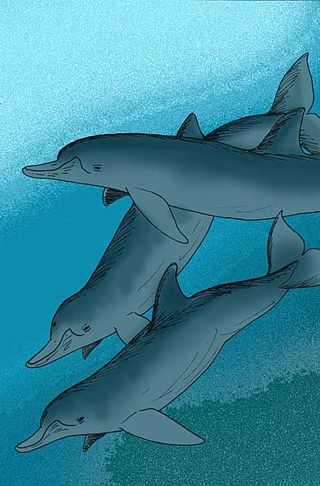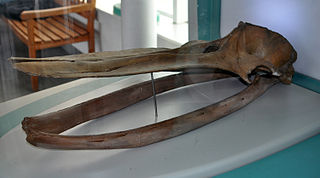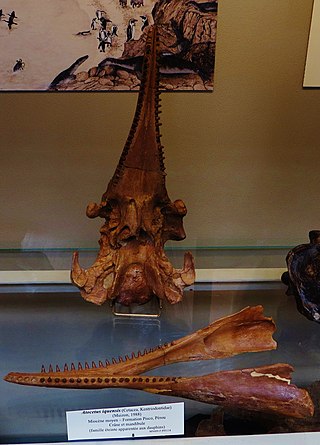
Prosqualodon is an extinct genus of Early to Middle Miocene cetacean from Argentina, Australia, New Zealand and Venezuela.

Brygmophyseter, known as the biting sperm whale, is an extinct genus of toothed whale in the sperm whale family with one species, B. shigensis. When it was first described in 1994, the species was placed in the genus Scaldicetus based on tooth morphology, but this was later revised in 1995. In 2006, it was classified into the genus Naganocetus, which is considered to be a junior synonym. The only known specimen, a nearly complete skeleton, was dated to be around 16–15 million years old. Brygmophyseter is thought to have been 6.5–7 meters (21–23 ft) long, and it probably had 11 or 12 teeth in the upper and lower jaws. Brygmophyseter is part of a group of macroraptorial sperm whales which tended to be apex predators using their large teeth to catch struggling prey such as whales. It had a spermaceti organ which was probably used for biosonar like in the modern sperm whale. The whale has made an appearance on The History Channel's TV series Jurassic Fight Club.

Australodelphis mirus is an extinct Pliocene dolphin. A. mirus is known from fossils found in the Sørsdal Formation, Mule Peninsula, Vestfold Hills, East Antarctica. The genus has been described as an example of convergent evolution with beaked whales.

Kentriodontidae is an extinct family of odontocete whales related to modern dolphins. The Kentriodontidae lived from the Oligocene to the Pliocene before going extinct.

Piscobalaena is an extinct genus of cetaceans, which lived from the Middle to Late Miocene epochs in Peru and Florida. Its fossils have been found in the Pisco Formation of Peru and the Bone Valley Formation of Florida. At least some individuals of this diminutive whale were preyed on by the shark O. megalodon.
Huaridelphis is an extinct genus of river dolphins from the Early Miocene. The type species is H. raimondii, found in the Chilcatay Formation of the Pisco Basin.

The Pisco Formation is a geologic formation located in Peru, on the southern coastal desert of Ica and Arequipa. The approximately 640 metres (2,100 ft) thick formation was deposited in the Pisco Basin, spanning an age from the Middle Miocene up to the Early Pleistocene, roughly from 15 to 2 Ma. The tuffaceous sandstones, diatomaceous siltstones, conglomerates and dolomites were deposited in a lagoonal to near-shore environment, in bays similar to other Pacific South American formations as the Bahía Inglesa and Coquimbo Formations of Chile.

Atocetus is an extinct genus of pontoporiid dolphin found in Miocene-age marine deposits in Peru and California.
Macrokentriodon is an extinct genus of giant dolphin once assigned to the paraphyletic/polyphyletic family Kentriodontidae. Remains have been found in the late Miocene (Serravallian) Choptank Formation of United States.
Notocetus is an extinct genus of river dolphin belonging to Squalodelphinidae. Known specimens have been found in Early Miocene marine deposits from Argentina, Italy and Peru.

Lophocetus is an extinct genus of dolphin belonging to the clade Delphinida that is known from late Miocene (Tortonian) marine deposits in California and Maryland. Although usually placed in Kentriodontidae, recent studies have found it only distantly related to Kentriodon.

Tiucetus is an extinct genus of cetotheriid baleen whale known from the Late Miocene Pisco Formation of Peru.

Brachydelphis is a genus of pontoporiid known from the Late Miocene Pisco Formation of Peru and the Bahía Inglesa Formation of Chile.
Tagicetus is an extinct genus of dolphin belonging to the polyphyletic family Kentriodontidae.
Chilcacetus is an extinct genus of primitive odontocete known from Early Miocene (Aquitanian) of Peru. Fossils were found in and named after the Chilcatay Formation of the Pisco Basin.

Balaenoptera siberi is an extinct species of baleen whale from the Late Miocene, described by Pilleri and Pilleri in 1989, based on fossils found in the Pisco Formation of the Pisco Basin in southwestern Peru.
Inticetus is an extinct genus of Early Miocene odontocete from the Chilcatay Formation, Pisco Basin, Peru.
Macrosqualodelphis is an extinct genus of river dolphins from the Early Miocene (Burdigalian) Chilcatay Formation of the Pisco Basin, Peru. The type species is M. ukupachai.
Pisco Basin is a sedimentary basin extending over 300 kilometres (190 mi) in southwestern Peru. The basin has a 2 kilometres (6,600 ft) thick sedimentary fill, which is about half the thickness of more northern foreland basins in Peru.










